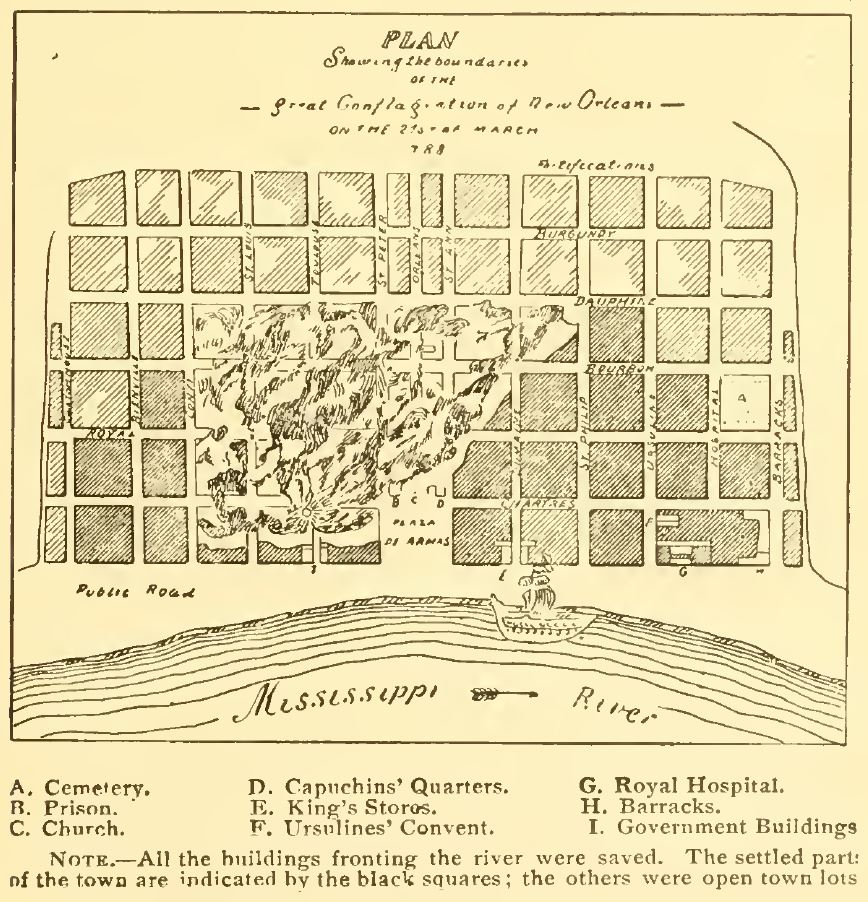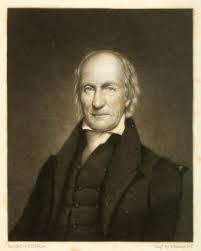 Home Page
Home Page
Required
- Miro. “The Great Fire of 1788.”
- The Ursuline Correspondence.
- de la Houssaye. "Françoise and Suzanne."
Optional
- Interview about Sidonie de la Houssay, part 1
- Interview about Sidonie de la Houssay, part 2
- The Great
New Orleans Fires. FrenchCreoles.com

The Great New Orleans Fires
1788 & 1794
Actually, New Orleans had two great fires, 1788 & 1794. The
French
Creoles website has a good article on both fires. Without
going back over the details of the fire, I do want to mention
that the fire was made worse because it was Good Friday and the
priests wouldn't ring the bells of St. Louis Parish Church (It
wasn't a cathedral yet.) to alert the town. 856 out of 1,100
total structures in the city burned. At the time, New Orleans
was limited to what's now called the French Quarter or Vieux
Carré.
Gov. Bienville appointed Adrien de Pauger to design the Vieux
Carré in 1720; he completed it in 1721. 300 years later, the
street plan is still in effect, with many of the streets still
bearing the names Pauger gave them. Pauger and chief engineer
Pierre Le Blond de La Tour supervised slaves, who built the
settlement using cypress wood, famous for its water resistence,
to build raised cottages. The fires swept most of these away. As
a result, the present look of the French Quarter is actually
Spanish, since 'Luisiana' was a Spanish colony at the time. Many
records had been saved from the fire by being thrown out of the
window of the building they were in. The king ordered a
fire-proof room be built to preserve records from future fires.
Also the Spanish established a stronger building code for the
city. Wooden buildings gave way to buildings with courtyards,
thick brick walls, arcades, and wrought-iron balconies. The
Place d'Armes (Jackson Square) began to take its current shape
with the Cabildo, the Presbytere, and the second version of St.
Louis Parish Church. St. Louis Cathedral took its present form
in 1850, the same year the Pontalba buildings were build on
either side of the Square.
Gov. Miro's letter to the king is remarkable for the depth its
poignancy, even in the English translation that we are reading.
He paints a vivid picture of the panic and suffering of the
people, of the work of 70 years gone in 5 hours. The account
combines both Miro's human reaction and his political
intentions: the more that he could move the king to pity the
situation, the more support he hoped the colony would receive.
He also drew the famous map of the the city burning. The printed
material at the bottom of the map was added later.


The Ursuline Correspondence
- Lecture.mp3
- Listen in iTunes
- Listen on Stitcher
-
The three letters in the Ursuline Correspondence give us an
insight into chuch-state relations before and after the
Louisiana Purchase, as well as the tension that came with the
merging of Catholic Creole Francophone Louisiana and the
Protestant Anglo English-speaking United States. It was not
obvious to either side that the merge would be successful.







Sidonie de la Houssaye
"A brief synthesis of Perretand Savoie’s biographies begins
with the author’s birth on August 17th 1820, on her father’s
plantation in St. John the Baptist Parish in Southeastern
Louisiana (Perret 8). Her given name was Hélène Perret. Her
father, Ursin Perret, came from a family of “moderately wealthy
sugar planters” who first came to Louisiana from Grenoble,
France in 1723 (10). Her maternal great-grandfather, Pierre
Bossié (Bossier), may have emigrated to Louisiana from Flandres,
and was also a planter. De la Houssaye claimed to have had a
private tutor as a child and later to have attended a convent
school briefly, but she was most likely primarily an autodidact
(16-17). By 1831, the family relocated to St. Mary Parish on the
Gulf Coast in south central Louisiana (18). At the age of
thirteen, she was married to Louis Pelletier Delahoussaye, who
was exactly twice her age.
The couple had six children, four of whom, three sons and a
daughter, survived to adulthood (27-28). In 1863, Louis was
killed, singled out as a representative of the law, his widow
alleged, by a secret southern mafia known as “Les Redoubtables”
who later found themselves villified in a novel of the same
name. During the 1870’s, Houssaye began to write, and published
her first work “Le Mari de Marguerite” in serial form in 1883.
By 1884, her correspondence with popular American author George
Cable was underway, and she was persistently seeking his help in
getting more of her own work published (42)" (Summarized from Harris
7-10).
The literary history of "Françoise and Suzanne" and "Alix de
Morainville" is intentionally murky, bordering on fraud. They
both appear in Strange True Stories of Louisiana by
George Washington Cable. But while the stories are strange
enough, some of them are of questionable. Cable wrote in a time
that privileged history over fiction, and his writings
offer a lot of both. "These conflicts are illustrated in
particularly vivid form in the texts of southern writer George
Cable, whom one could call a man of letters with the sensibility
of a historian or a historian with literary sensibilities" (Castillo 20).
Cable loved to work real people into his historical novels. In
November 1888, Cable began publishing the Strange True
Stories in serial form in Century magazine, and
then combined them in a book. Three of the stories came from
Sidonie de la Houssaye — these two and "The Young Aunt with
White Hair," a wild yarn about a young French woman who was
kidnapped and partially canabalized by a local tribe, before she
was rescued. Here is Cable's account of how he got the two
stories.
I took it to an attorney, and requested him, under certain strict conditions, to obtain it for me with all its rights.
"What is it?"
"It is the minute account, written by one of the travelers, a pretty little Creole maiden of seventeen, of an adventurous journey made, in 1795, from New Orleans through the wilds of Louisiana, taking six weeks to complete a tour that could now be made in less than two days."
But this is written by some one else; see, it says

"Yes," I rejoined, "it purports to be a copy. We must have the little grandmother's original manuscript, written in 1822; that or nothing."
So a correspondence sprang up with a gentle and refined old Creole lady with whom I later had the honor to become acquainted and now count among my esteemed friends—grand-daughter of the grandmother who, after innumerable recountings by word of mouth to mother, sisters, brothers, friends, husband, children, and children's children through twenty-seven years of advancing life, sat down at last and wrote the oft-told tale for her little grand-children, one of whom, inheriting her literary instinct and herself become an aged grandmother, discovers the manuscript among some old family papers and recognizes its value. The first exchange of letters disclosed the fact that the "New Orleans Bee" ("L'Abeille") had bought the right to publish the manuscript in French; but the moment its editors had proper assurance that there was impending another arrangement more profitable to her, they chivalrously yielded all they had bought, on merely being reimbursed.
The condition that required the delivery of the original manuscript, written over sixty years before, was not so easily met. First came the assurance that its spelling was hideous, its writing bad and dimmed by time, and the sheets tattered and torn. Later followed the disclosure that an aged and infirm mother of the grandmother owned it, and that she had some time before compelled its return to the private drawer from which the relic-loving daughter had abstracted it. Still later came a letter saying that since the attorney was so relentlessly exacting, she had written to her mother praying her to part with the manuscript. Then followed another communication,—six large, closely written pages of despair,—inclosing a letter from the mother. The wad of papers, always more and more in the way and always "smelling bad," had been put into the fire. But a telegram followed on the heels of the mail, crying joy! An old letter had been found and forwarded which would prove that such a manuscript had existed. But it was not in time to intercept the attorney's letter saying that, the original manuscript being destroyed, there could be no purchase or any need of further correspondence. The old letter came. It was genuine beyond a doubt, had been written by one of the party making the journey, and was itself forty-seven years old. The paper was poor and sallow, the hand-writing large, and the orthography—!

But let us translate:
st. john baptist[1] 10 august 1836
My very dear Niece. I received your letter this morning in which you ask me to tell you what I remember of the journey to Attakapas made in 1795 by papa, M. ——-, [and] my younger sister Françoise afterward your grandmother. If it were with my tongue I could answer more favorably; but writing is not my forte; I was never calculated for a public writer, as your grandmother was. By the way, she wrote the journey, and very prettily; what have you done with it? It is a pity to lose so pretty a piece of writing.... We left New Orleans to go to the Attakapas in the month of May, 1795, and in an old barge ["vieux chalant qui senté le rat mord a plien nez"]. We were Françoise and I Suzanne, pearl of the family, and Papa, who went to buy lands; and one Joseph Charpentier and his dear and pretty little wife Alix [whom] I love so much; 3 Irish, father mother and son [fice]; lastly Mario, whom you knew, with Celeste, formerly lady's maid to Marianne—who is now my sister-in-law.... If I knew better how to write I would tell you our adventures the alligators tried to devour us. We barely escaped perishing in Lake Chicot and many other things.... At last we arrived at a pretty village St. Martinville called also little Paris and full of barons, marquises, counts and countesses[2] that were an offense to my nose and my stomach. Your grandmother was in raptures. It was there we met the beautiful Tonton, your aunt by marriage. I have a bad finger and must stop.... Your loving aunty [ta tantine qui temme]
Suzanne —— née ——
The kind of letter to expect from one who, as a girl of eighteen, could shoot and swim and was called by her father "my son"; the antipode of her sister Françoise. My attorney wrote that the evidence was sufficient.
His letter had hardly got into the mail-bag when another telegram cried hold! That a few pages of the original manuscript had been found and forwarded by post. They came. They were only nine in all—old, yellow, ragged, torn, leaves of a plantation account-book whose red-ruled columns had long ago faded to a faint brown, one side of two or three of them preoccupied with charges in bad French of yards of cottonade, "mouslin à dames," "jaconad," dozens of soap, pounds of tobacco, pairs of stockings, lace, etc.; but to our great pleasure each page corresponding closely, save in orthography and syntax, with a page of the new manuscript, and the page numbers of the old running higher than those of the new! Here was evidence which one could lay before a skeptical world that the transcriber had not expanded the work of the original memoirist. The manuscript passed into my possession, our Creole lady-correspondent reiterating to the end her inability to divine what could be wanted with "an almost illegible scrawl" (griffonage), full of bad spelling and of rather inelegant diction. But if old manuscript was the object of desire, why, here was something else; the very document alluded to by Françoise in her memoir of travel—the autobiography of the dear little countess, her beloved Alix de Morainville, made fatherless and a widow by the guillotine in the Reign of Terror.
"Was that all?" inquired my agent, craftily, his suspicions aroused by the promptness with which the supply met the demand. "Had she not other old and valuable manuscripts?"
"No, alas! Only that one."
Thus reassured, he became its purchaser. It lies before me now, in an inner wrapper of queer old black paper, beside its little tight-fitting bag, or case of a kind of bright, large-flowered silken stuff not made in these days, and its outer wrapper of discolored brief-paper; a pretty little document of sixty-eight small pages in a feminine hand, perfect in its slightly archaic grammar, gracefully composed, and, in spite of its flimsy yellowed paper, as legible as print: "Histoire d'Alix de Morainville écrite à la Louisiane ce 22 Aout 1795. Pour mes chères amies, Suzanne et Françoise Bossier."
One day I told the story to Professor Charles Eliot Norton of Harvard University. He generously offered to see if he could find the name of the Count de Morainville on any of the lists of persons guillotined during the French Revolution. He made the search, but wrote, "I am sorry to say that I have not been able to find it either in Prudhomme, 'Dictionnaire des Individues envoyés à la Mort judiciairement, 1789-1796,' or in the list given by Wallon in the sixth volume of his very interesting 'Histoire du Tribunal Revolutionnaire de Paris.' Possibly he was not put to death in Paris," etc. And later he kindly wrote again that he had made some hours' further search, but in vain.
Here was distress. I turned to the little manuscript roll of which I had become so fond, and searched its pages anew for evidence of either genuineness or its opposite. The wrapper of black paper and the close-fitting silken bag had not been sufficient to keep it from taking on the yellowness of age. It was at least no modern counterfeit. Presently I noticed the total absence of quotation marks from its passages of conversation. Now, at the close of the last century, the use of quotation marks was becoming general, but had not become universal and imperative. Their entire absence from this manuscript of sixty-eight pages, abounding in conversations, meant either age or cunning pretense. But would a pretender carry his or her cunning to the extreme of fortifying the manuscript in every possible way against the sallowing touch of time, lay it away in a trunk of old papers, lie down and die without mentioning it, and leave it for some one in the second or third generation afterward to find? I turned the leaves once more, and lo! one leaf that had had a large corner torn off had lost that much of its text; it had been written upon before it was torn; while on another torn leaf, for there are two, the writing reads—as you shall see—uninterruptedly around the torn edge; the writing has been done after the corner was torn off. The two rents, therefore, must have occurred at different times; for the one which mutilates the text is on the earlier page and surely would not have been left so by the author at the time of writing it, but only by some one careless of it, and at some time between its completion and the manifestly later date, when it was so carefully bestowed in its old-fashioned silken case and its inner wrapper of black paper. The manuscript seemed genuine. Maybe the name De Morainville is not, but was a convenient fiction of Alix herself, well understood as such by Françoise and Suzanne. Everything points that way, as was suggested at once by Madame Sidonie de la Houssaye —There! I have let slip the name of my Creole friend, and can only pray her to forgive me! "Tout porte à le croire" (Everything helps that belief), she writes; although she also doubts, with reason, I should say, the exhaustive completeness of those lists of the guillotined. "I recall," she writes in French, "that my husband has often told me the two uncles of his father, or grandfather, were guillotined in the Revolution; but though search was made by an advocate, no trace of them was found in any records."
An assumed name need not vitiate the truth of the story; but discoveries made since, which I am still investigating, offer probabilities that, after all, the name is genuine.
We see, however, that an intention to deceive, were it supposable, would have to be of recent date.
Now let me show that an intention to deceive could not be of recent date, and at the same time we shall see the need of this minuteness of explanation. Notice, then, that the manuscript comes directly from the lady who says she found it in a trunk of her family's private papers. A prominent paper-maker in Boston has examined it and says that, while its age cannot be certified to from its texture, its leaves are of three different kinds of paper, each of which might be a hundred years old. But, bluntly, this lady, though a person of literary tastes and talent, who recognized the literary value of Alix's history, esteemed original documents so lightly as, for example, to put no value upon Louisa Cheval's thrilling letter to her brother. She prized this Alix manuscript only because, being a simple, succinct, unadorned narrative, she could use it, as she could not Françoise's long, pretty story, for the foundation of a nearly threefold expanded romance. And this, in fact, she had written, copyrighted, and arranged to publish when our joint experience concerning Françoise's manuscript at length readjusted her sense of values. She sold me the little Alix manuscript at a price still out of all proportion below her valuation of her own writing, and counting it a mistake that the expanded romance should go unpreferred and unpublished.
But who, then, wrote the smaller manuscript? Madame found it, she says, in the possession of her very aged mother, the daughter and namesake of Françoise. Surely she was not its author; it is she who said she burned almost the whole original draft of Françoise's "Voyage," because it was "in the way and smelt bad." Neither could Françoise have written it. Her awkward handwriting, her sparkling flood of words and details, and her ignorance of the simplest rules of spelling, make it impossible. Nor could Suzanne have done it. She wrote and spelled no better at fifty-nine than Françoise at forty-three. Nor could any one have imposed it on either of the sisters. So, then, we find no intention to deceive, either early or recent. I translated the manuscript, it went to the magazine, and I sat down to eat, drink, and revel, never dreaming that the brazen water-gates of my Babylon were standing wide open.
For all this time two huge, glaring anachronisms were staring me, and half a dozen other persons, squarely in the face, and actually escaping our notice by their serene audacity. But hardly was the pie—I mean the magazine—opened when these two birds began to sing. Wasn't that—interesting? Of course Louis de la Houssaye, who in 1786 "had lately come from San Domingo," had not "been fighting the insurgents"—who did not revolt until four or five years afterward! And of course the old count, who so kindly left the family group that was bidding Madelaine de Livilier good-bye, was not the Prime Minister Maurepas, who was not "only a few months returned from exile," and who was not then "at the pinnacle of royal favor"; for these matters were of earlier date, and this "most lovable old man in the world" wasn't any longer in the world at all, and had not been for eight years. He was dead and buried.
And so, after all, fraudulent intent or none, this manuscript, just as it is, could never have been written by Alix. On "this 22d of August, 1795," she could not have perpetrated such statements as these two. Her memory of persons and events could not have been so grotesquely at fault, nor could she have hoped so to deceive any one. The misstatements are of later date, and from some one to whom the two events were historical. But the manuscript is all in one simple, undisguised, feminine handwriting, and with no interlineation save only here and there the correction of a miswritten word.
Now in translating madame's "Voyage de ma Grandmère," I noticed something equivalent to an interlineation, but in her own writing like all the rest, and added in a perfectly unconcealed, candid manner, at the end of a paragraph near the close of the story. It struck me as an innocent gloss of the copyist, justified in her mind by some well-credited family tradition. It was this: "Just as we [Françoise and Alix] were parting, she [Alix] handed me the story of her life." I had already called my friend's attention to the anachronisms, and she was in keen distress, because totally unable to account for them. But as I further pondered them, this gloss gained new significance and I mentioned it. My new inquiry flashed light upon her aged memory. She explained at once that, to connect the two stories of Françoise and Alix, she had thought it right to impute these few words to Françoise rather than for mere exactness to thrust a detailed explanation of her own into a story hurrying to its close. My question called back an incident of long ago and resulted first in her rummaging a whole day among her papers, and then in my receiving the certificate of a gentleman of high official standing in Louisiana that, on the 10th of last April (1889), this lady, in his presence, took from a large trunk of written papers, variously dated and "appearing to be perfectly genuine," a book of memoranda from which, writes he, "I copy the following paragraph written by Madame S. de la Houssaye herself in the middle of the book, on page 29." Then follows in French:
June 20, 1841.—M. Gerbeau has dined here again. What a singular story he tells me. We talked of my grandmother and Madame Carpentier, and what does M. Gerbeau tell me but that Alix had not finished her history when my grandmother and my aunt returned, and that he had promised to get it to them. "And I kept it two years for want of an opportunity," he added. How mad Grandmamma must have been! How the delay must have made her suffer!
Well and good! Then Alix did write her story! But if she wrote for both her "dear and good friends," Suzanne and Françoise, then Françoise, the younger and milder sister, would the more likely have to be content, sooner or later, with a copy. This, I find no reason to doubt, is what lies before me. Indeed, here (crossed out in the manuscript, but by me restored and italicized) are signs of a copyist's pen: "Mais helas! il desesperoit de reussir quand' il desespe rencontra," etc. Is not that a copyist's repetition? Or this:"—et lui, mon mari apres tout se fit mon marim domestique." And here the copyist misread the original: "Lorsque le maire entendit les noms et les personnes prenoms de la mariée," etc. In the manuscript personnes is crossed out, and the correct word, prenoms, is written above it.
Whoever made this copy it remains still so simple and compact that he or she cannot be charged with many embellishments. And yet it is easy to believe that some one, with that looseness of family tradition and largeness of ancestral pride so common among the Creoles, in half-knowledge and half-ignorance should have ventured aside for an instant to attribute in pure parenthesis to an ancestral De la Houssaye the premature honor of a San Domingan war; or, incited by some tradition of the old Prime Minister's intimate friendship with Madelaine's family, should have imputed a gracious attention to the wrong Count de Maurepas, or to the wrong count altogether.
I find no other theory tenable. To reject the whole matter as a forgery flies into the face of more incontestable facts than the anachronisms do. We know, from Suzanne and Françoise, without this manuscript, that there was an Alix Carpentier, daughter of a count, widow of a viscount, an emigrée of the Revolution, married to a Norman peasant, known to M. Gerbeau, beloved of Suzanne and Françoise, with whom they journeyed to Attakapas, and who wrote for them the history of her strange life. I hold a manuscript carefully kept by at least two generations of Françoise's descendants among their valuable private papers. It professes to be that history—a short, modest, unadorned narrative, apparently a copy of a paper of like compass, notwithstanding the evident insertion of two impossible statements whose complete omission does not disturb the narrative. I see no room to doubt that it contains the true story of a real and lovely woman. But to come back to my attorney.
"Françoise and Suzanne"
I view this introduction as being a framing device for our
stories, somewhat like the ones in the Canterbury Tales.
Cable uses the introduction to set the mood for the stories
themselves. The one element I've been able to confirm is that
these stories were written in French by a Sidonie de la
Houssaye. She wrote all her stories in French. She is best knows
for a series of novels, Les Quarteronnes de La Nouvelle
Orléans. A quarteronne, or quadroon, light-skinned black
person. They frequently show up in stories about the Tragic
Mulatto, and Sidonie wrote very melodramatic stories. Because
her novels haven't been reprinted or translated until recently,
these are her best-known stories. Cable was helping her get her
stories into publication, but I'm not sure how much he paid her
for her work. At the very least, he opened the door for her to
publish other material.
I don't think that she tried to pass off her stories as history
— Cable casts himself as the sleuth who verified them, and he
produces 'evidence' confirming their historicity. Regardless,
they make great stories. "The Adventures of Françoise and
Suzanne" introduces us to Suzanne and Françoise, who go on a
flatboat trip with their father Pierre Bossier, where they meet
their mysterious fairy godmother, Alix Carpentier. The story
starts with an attempted Francophile revolt led by George Rogers
Clark and the Pointe Coupée slave revolt of 1795, real
conspiracies that I suspect that Cable inserted in the story.
Betrayed by informants among the Tunica Tribe, the plot was uncovered and trials took place in May 1795. Many accused conspirators swore that they took part in the plot only because of violent intimidation by its ringleaders. Ultimately, fifty-seven slaves and three whites were convicted of participation, and twenty-three of those convicted were executed, with their severed heads nailed to poles along the Mississippi River’s banks in keeping with an old tradition of exemplary punishment. (64 Parishes)
The punishment of beheading slaves and placing their heads on
pikes along the Mississippi as a warning to others was a popular
practice in early Louisiana, and is commemorated at the Whitney
Plantation.

Papa proposes that the two girls accompany him from their
plantation St. James Parish (above New Orleans along the German
Coast) to New Orleans then on to St. Martinville near Lafayette,
land formerly held by the cannibalistic Attakapas. This part
seems more de la Houssaye, given her interest in cannibalism.
St. Martinville had become associated with the story of
Evangeline, who in the re-written version met her lover Gabriel
under an oak by Bayou Teche. Town fathers have identified an
appropriate tree near the bayou and the sidewalk to be the
Evangeline Oak. Actress Delores Del Rio, who played Evangeline
in the movie, was so moved by the story of the Evangeline Oak
that she donated a statue of Evangeline, with her as the model.
In addition to the other fantasies, catastrophes, and crimes
against humanity swirling around the edges of the story, we soon
find a colony of French nobility fleeing the French Revolution.
Naturally they have a ball, and the girls' new friend Alix
Carpentier produces some of her old gowns she wore when she was
a lady in waiting for Marie Antoinette. As far as I can tell,
the Versailles on the Têche is as mythic as Evangeline and
Gabriel on the Têche. But in Louisiana, we love our stories.
"Alix de Morainville."
So where does a bayou fairy godmother come from? The next story
is a prequel explaining how Alix went from being a lady in
waiting for Marie Antoinette to being a commoner's wife on a
farm near Lafayette and St. Martinville. It's a tale of love in
a time of revolution. Before the war, Alix lived a life of
lonely privilege (The poor little rich girl is a standard trope
of melodrama.). Her parents were busy at court, leaving her to
grow up with the family of the gardener, Guillaume Carpenter.
It's long been common among the upper classes to use staff for
the bulk of the child care for their children. Through the
course of the story, it becomes clear that her foster brother
Joseph has been in love with her since they were children, icky
as that sounds. In due time (when she was 14, but no bigger than
a 10 year old) her parents espoused her off to Viscomte Abner de
Morainville, and she was turned over to the Ursulines for her
education. Notice that while in the convent, she makes a friend
who connects her to Louisiana and to the de la Houssayes, her
husband's family. She graduated from the convent and got married
at the age of 16, and became active in court life. Soon enough,
the French Revolution intervened. Alix in short order lost her
husband, her father, and her mother, who died in England of
natural causes.
The Carpentiers hid Alix as long as they could, but she was
inevitably discovered. Joseph proposed a desperate scheme to
save her — marriage. By renouncing her title and marrying a
commoner, Alix could become a commoner herself. Horrified at
first, Alix came around to the idea when Joseph explained that
it would be a sham marriage that would end when they reached
England. The old order was so embedded in her mind that she
never considered a real relationship with Joseph until he was
leaving for Louisiana. Unable to bear the thought of losing him,
she made a real commitment to the relationship and followed him
to Louisiana.
 Home Page
Home Page